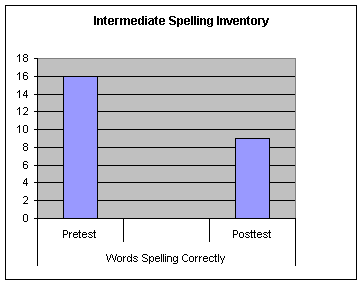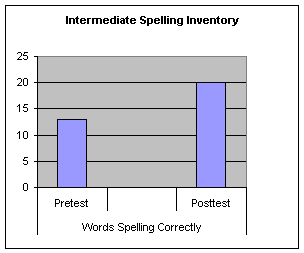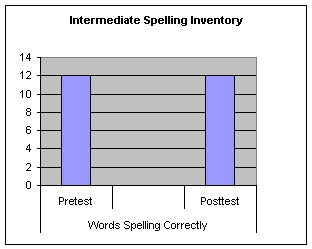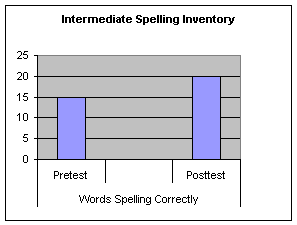
Summary of Findings by Type Summary of Findings by Feature Pre and Post Change Limitations
![]()
Discussion of Findings
Method of Assessment
This study was an attempt to verify if teacher intervention affected students' decoding and encoding fluency through targeted small group lessons in the area of developmental spelling (Bear, Invernizzi, Templeton, & Johnson, 2004). The explicit instruction of word strategies and teacher modeling activated student effort to create connection between known spelling patterns to unfamiliar spelling patterns. In addition, the teacher established the amount of acquired word knowledge that the child transferred into his/her daily work. Using the developmental spelling approach, allowed the teacher to incorporate word strategies into the instruction at the child’s zone of proximal development. At the onset of the study, this teacher/researcher played an active role as facilitator and model. Once the study was underway, this teacher/researcher gradually released responsibility to the students to decode and encode independently while reading text and completing written retellings.
Upon the conclusion of the study, some of the students were able to exhibit an increase in developmental spelling and independent reading levels. The assessment results reflected growth and understanding of increased word knowledge.
Intermediate Spelling Inventory (Bear, Invernizzi, Templeton, Johnson), was used as the assessment that determined the developmental spelling level of each student at the onset of the research study. The intermediate spelling inventory is quick and easy to administer and score. One specialized list of words covers a range of spelling levels. The range spans from an emergent level to derivational spelling levels. The words in the spelling inventory are developed to show the students’ knowledge of key spelling features that relate to the different spelling stages. The lists are not exhaustive in that they do not test all the spelling features; rather they include orthographic features that are most helpful in understanding where to begin instruction (Bear, Invernizzi, Templeton, Johnson, 2004). The teacher administers the spelling inventory just as he/she would a spelling test. The only difference is that the children do not study for the spelling inventory. The scoring is done through a point system. Points are assigned to certain phonetic features present within the given words. The spelling score can predict reading achievement. The analysis of the inventory helps to determine the developmental spelling stage of the child. Once knowing the developmental level, the teacher can then plan word study lessons that are appropriate for the child. The use of the developmental spelling inventory requires three basic steps: (a) selecting and administering the inventory, (b) analyzing the students’ spelling, and (c) monitoring growth and planning instruction (Bear, Invernizzi, Templeton, Johnson, 2004). Finally, the most important task is to meet the assessed needs of the children.
The Running Record is a record of reading behaviors that a reader makes while reading. Dr. Marie Clay (1993) developed the Running Record. She developed the Running Record as a way for teachers to quickly and informally assess the students the class. This type of assessment enables the teacher to get a clearer picture as to what cueing systems the children use while reading. The teacher wants to capture the child’s normal reading behaviors. One of the best times to use a running record is when the child is reading a self-selected reading book. Performing a running record at this time will allow the teacher to observe if the book that is chosen is “just right” for the child. The teacher listens to the child’s reading performance. While listening, the teacher is interested in what the child does when he/she encounters a word that puzzles him/her. When this happens, the child needs to monitor and correct any miscues that might occur. The teacher records any miscues that occur using symbols that can be analyzed at a later time. The cueing systems or miscues that the teacher assesses are those that affect meaning of the text being read (semantic), or miscues that effect letter-sound correspondence to decode words (graphophonic). Finally, miscues that effect sentence structure (syntactic). Once the teacher has analyzed the miscues, he/she is aware of the child’s reading level. If the child’s score falls between 95% - 100% the child is reading an easy text which is in his/her independent level of reading. A score between 90% - 94% the child is reading a text in his/her instructional level of reading. A score between 80% - 89% the child is reading a text that is very difficult for him/her and istherefore athis/her frustration level of reading.
Traditionally, written retelling or written response of a narrative text includes the major elements of the story. The story is told sequentially, and the student makes casual connections between the events in the story clear (Caldwell, & Leslie, 2005). In addition, the retelling or response connects prior knowledge for a development of understanding of a story. To improve the students' abilities to retell or respond to a narrative story, they need to be exposed to many stories from an early age. Exposure to many stories will enhance their knowledge of story elements (characters, setting, events, problem, and resolution). Story retellings can be either oral or written. A written story retelling has the same components as an oral one, only the teacher looks for written elements as well as story elements. The written components of a retelling encompass the writing process such as sentence structure, mechanics, and spelling conventions. This teacher/researcher looked for transfer of spelling strategies from the explicit lesson to the written responses. This teacher/researcher was also aware of the use of transitional words and sentence variation. The written retelling was aided by the teacher/researcher supplying the student with questions to answer or unaided, where the student writes a retelling from their memory of the story. Rubrics were used to assess the written components of the written retelling.
Developmental Reading Assessment (DRA) is an informal reading assessment that assesses student-reading performance in the following areas: engagement, oral reading fluency, comprehension skills, and strategies. When the teacher/researcher conducted the assessment, the first step was to complete the student reading survey. The teacher needed to allow approximately 10 – 15 minutes for completion. The student survey asked the student to recall his/her reading for the past few months. The student was allowed to use his/her reading log to help him/her remember the books that were read. The second step was a one-on-one reading conference. During the conference, the child selected a book to read from the set of books that the teacher/researcher had already established to be the most appropriate for the child. The purpose of this phase was to document the student’s oral reading fluency, in addition to establishing the student’s independent reading level. The reading conference generally lasted about 5 -10 minutes. The third and final step was when the student read the entire text he/she has selected silently; when finished the student gave an oral retelling to the teacher. The teacher may have prompted the student if he/she gave insufficient details during the retelling.
Summary of the Findings By Type
All students were assessed using the Developmental Reading Assessment (DRA) and
Intermediate Spelling Inventory in January and May. In January, all students fell in the within word spelling pattern stage. In May, two students stayed within the same developmental spelling stage, and two students increased into the late syllables and affixes / early derivational stage. The components of the DRA included accuracy, comprehension and fluency. The students had one or two point discrepancies in these areas from January to May. However, three students increased one independent reading level, and one student increased two independent reading levels. The researcher also informally assessed the written work that was completed during the intervention period. All students improved in some area of the study. In the area of written work, three of the students fluctuated and one student stayed constant.


Student 1 was administered the Intermediate Spelling Assessment in January and May. Student 1’s accuracy on the assessment declined. He spelled 16 out of 25 words correctly before intervention and 9 out of 25 words after intervention. As a result, he stayed within the same developmental spelling stage (within word pattern). Student 1 was also administered the Developmental Reading Assessment in January, an independent reading level of 40 was achieved. Post intervention, he increased one independent reading level to a 44.
Written responses were evaluated at the onset of the research study. Student 1 stayed constant concerning written work. He stayed with common language and did not take risks to use language that is more complex.
Running records were also part of the assessment process. The teacher/ researcher administered running records during D.E.A.R. time. During silent reading time, the teacher/ researcher administered a running record. This was to determine if it was a “just right” book, and how the student was transferring the information from the intervention. Student 1’s informal running records showed that he self-corrected and self-monitored. His miscues did not affect meaning. Student 1 chose books within his independent range. Student 1 did not have difficulty decoding multi-syllabic words and he read with prosody. His reading skills were slightly above grade level. Although his encoding skills are slightly below grade level.


Student 2 was administered the Intermediate Spelling Assessment in January and May. His accuracy on the assessment increased by seven more words being spelled correctly. Student 2 spelled 13 out of 25 words correctly before intervention and 20 out of 25 words after intervention; although he increased from within-word stage into the syllables and affixes stage. He was also administered the Developmental Reading Assessment in January, an independent reading level of 28 was achieved. Post intervention, Student 2 increased one independent reading level to a 30.
Written responses were evaluated at the onset of the research study. Student 2 fluctuated concerning written work. He wrote responses quickly and gave no thought to spelling. Student 2 wanted the assignment to be completed as soon as possible.
Running records were also part of the assessment process. The researcher administered running records during D.E.A.R. time. During silent reading time, the researcher administered a running record. This was to determine if it was a “just right” book, and how the student was transferring the information from the intervention. Student 2’s informal running records showed that he did not self-correct and had many miscues. Student 2 always chose books out of his independent range, which resulted in poor reading ability. He had a difficult time with fluency because of decoding difficulty of multi-syllabic words. Student 2’s reading was slightly below grade level.


Student 3 was administered the Intermediate Spelling Assessment in January and May. Her accuracy on the assessment was constant. Student 3 spelled 12 out of 25 words correctly before intervention and 12 out of 25 words after intervention. Student 1 stayed at the same developmental spelling stage even though she spelled different words incorrectly. Student 3 was also administered the Developmental Reading Assessment in January, an independent reading level of 28 was achieved. Post intervention, she increased one independent reading level to a 30. Running records were also a part of the assessment piece.
Written responses were evaluated at the onset of the research study. Student 3’s errors decreased as the study continued. She gave thought and concern while completing written work. Student 3 was very methodical to the given task. Although, Student 3 stayed with very common language, the errors declined as the study continued.
Running records were also part of the assessment process. The researcher administered running records during D.E.A.R. time. During silent reading time, the researcher administered a running record. This was to determine if it was a “just right” book, and how the student was transferring the information from the intervention. Student 3’s informal running records showed that she did not self-correct very often and had some miscues. Student 3 had a difficult time pronouncing some words and the researcher attributes this to her partial hearing loss. Student 3 worked very hard and is aware of her difficulty with decoding. She did choose books within her independent range, although her decoding skills are still slightly below grade level.


Student 4 was administered the Intermediate Spelling Assessment in January and May. Her accuracy on the assessment increased by five more words being spelled correctly. Student 4 spelled 15 out of 25 words correctly before intervention and 20 out of 25 words after intervention. Student 4 increased her developmental spelling stage into the syllables & affixes spelling stage. She was also administered the Developmental Reading Assessment in January, an independent reading level of 28 was achieved. Post intervention, Student 4 increased two independent reading levels to a 34. Running records were also a part of the assessment piece.
Written responses were evaluated at the onset of the research study. Student 4’s errors stayed within the same range concerning written work. She did not vary the complexity of words, nor did she improve on the common mistakes.
Running records were also part of the assessment process. The researcher administered running records during D.E.A.R. time. During silent reading time, the researcher administered a running record. This was to determine if it was a “just right” book, and how the student was transferring the information from the intervention. Student 4’s informal running records showed that she did self-correct and self-monitor while reading text. Her miscues did not affect meaning, and she chose silent reading books within her independent reading level. Student 4 became aware that she was improving and was delighted.
Summary of the Findings for Each Student Pre and Post by Feature


Student 1 was administered the Developmental Reading Assessment. His accuracy stayed constant from pretest to posttest (99%), comprehension was stable (24), and fluency was stable as well (19). However, Student 1 increased his independent reading level from an independent 40 to an independent 44. Student 1 has internalized the feature of long and short vowels, although vowel digraphs, diphthongs and the “dge” features are still problematic. These errors kept his developmental spelling stage at the within word stage. His incorrect spelling feature errors increased by six features from pretest to posttest. These increased errors continue to revolve around silent letters and the spelling multi-syllabic words.


Student 2 was administered the Developmental Reading Assessment. He had an increase of 4 percentage points in accuracy from pretest to posttest (94% up to 98%), a decrease of one point in comprehension (19 down to 18), and an increase of one point in fluency (14 up to 15). However, Student 2 increased his independent reading level from an independent 28 to an independent 30. Student 2 has internalized long and short spelling patterns, “dge”, vowel digraphs and diphthongs. He moved into the next developmental spelling stage syllables and affixes. His incorrect spelling features decreased from pretest to posttest by six features. His errors revolved around derivational spellings on the posttest He has worked hard to improve his spelling accuracy.


Student 3 was administered the Developmental Reading Assessment. She had a decrease
of 4 percentage points in accuracy from pretest to posttest (99% down to 95%), a decrease of one point in comprehension (19 down to 18), and a decrease of two points in fluency ( 19 down to 17). However, Student 3 increased her independent reading level from an independent 28 to an independent 30. Student 3 has internalized basic long and short vowel patterns. She still has difficulty with vowel digraphs and diphthongs. A contributing factor is her hearing impairment. She stayed within the same developmental spelling stage. Her incorrect spelling features increased from pretest to posttest by one feature. Her increased errors continue to evolve around silent letters and spelling multi-syllabic words.


Student 4 was administered the Developmental Reading Assessment. She had an increase of 1 percentage point in accuracy from pretest to posttest (97% up to 98%), comprehension stayed constant (18), and fluency stayed constant (15). However, Student 2 increased her independent reading level from an independent 28 to an independent 34. Student 4 has internalized long and short vowel patterns, vowel digraphs, diphthongs, and many early suffix rules. Student 4 has moved into the late syllable and affix / early derivational spelling stage. Her incorrect spelling features decreased from pretest to posttest by six features. Most of the errors revolved around three derivational spelling stage words on the posttest. She has worked extremely hard during the intervention period to improve her spelling accuracy.
Discussion of Pre and Post Change for All Students
All students were assessed in January and May. The assessments did show some growth in all students. One of the four students decreased in the number of words spelled correctly from pretest to posttest. One out of the four students spelled the same number of words correctly from pretest to posttest, although they were not the same words or spelling features. Two out of the four students increased words spelled correctly from pretest to posttest. Two out of the four students increased developmental spelling levels. Three out of the four students increased one independent reading level, and one student increased two independent reading levels. Individual features of the assessments fluctuated within the assessment level for given students. Written responses also fluctuated. Depending on the assignment and the students' focus level, the written responses had evidence of errors. The word errors were not always consistent and their word choice was still at a basic level. Although one student did decrease in fluency, all others either increased or remained constant.
Discussion of Pre and Post Change for Each Student
Student 1
It was found that Student 1 did not exhibit significant positive change. He spelled more words incorrectly on his intermediate spelling inventory in May than in January. However, he remained in the same developmental spelling stage. However, he increased his independent reading level from a 40 to a 44. Student 1’s written work stayed constant throughout the intervention period. He exhibited one error each time the teacher/researcher collected samples. At the conclusion of the study, the teacher/researcher noted that Student 1 does need to internalize spelling patterns in order to move into the next spelling stage. He was at the time, within word spelling stage which is slightly below grade level.
Student 2
It was found that Student 2 exhibited a positive increase. He increased words spelled correctly on his intermediate spelling inventory in May. Thus, he increased his developmental spelling level to the next stage of late syllables & affixes/early derivational. Student 2 also increased one independent reading level. However, Student 2’s written work fluctuated with the amount of errors. He had no common spelling mistakes or consistency within word patterns. Furthermore, Student 2’s independent reading level increased from 28 to 30. His accuracy score increased from 94% to 98%, and his comprehension and fluency had insignificant discrepancy from pretest to posttest. At the conclusion of the study, the teacher/researcher noted that Student 2 had improved in his spelling accuracy. He has moved into the next spelling stage and shows continued improvement with focused spelling instruction.
Student 3
It was found that Student 3 exhibited an overall positive increase. She had no increase on the intermediate spelling inventory. Although she spelled the same number of words correctly on pretest and posttest, the word patterns and spelling features differed. Keeping that in mind, Student 3’s written work fluctuated as the amount of errors increased. She had no common spelling mistakes or consistency within word patterns. However, Student 3 did increase one independent reading level from 28 to 30. Although her accuracy score decreased from 99% to 95%, her comprehension and fluency had insignificant discrepancy from pretest to posttest. At the conclusion of the study, the teacher/researcher noted that Student 3 has stayed constant in her spelling accuracy. She needed visual cues in order to internalize the spelling patterns. Her hearing impairment inhibits her success.
Student 4
It was found that Student 4 exhibited the most significant overall change among the research candidates. She increased her developmental spelling inventory score from pretest to posttest. Even though her written work was stable for transfer, her developmental level spelling increased to the late syllable and affix /early derivational spelling stage. Furthermore, her independent reading level increased from 28 to 34. Her accuracy increased from 97% to 98%, and her comprehension and fluency stayed the same (18, 15 respectively). At the conclusion of the study, the teacher/researcher noted Student 4 has made tremendous growth in her spelling accuracy. He has internalized many spelling patterns and features. She would benefit from focused spelling instruction.
There were many limitations during this research study. During the entire research study, the teacher/ researcher had a student teacher in the classroom. As a result, the student teacher had “take over” days in which the researcher could not have contact with the children while the student teacher was instructing. This altered the intervention in which the researcher had to reschedule the group meetings. Some of the students missed the session because of absences. In addition, during the months of intervention the students were involved in the Massachusetts Comprehensive Assessment System (MCAS) testing. The students needed focus attention on preparing for the MCAS test. The researcher needed to review curriculum material in addition to the administration of the assessment. The researcher lost more than two weeks of full intervention sessions. Another limitation was that one of the participants has a hearing impairment. The researcher believes that because of the hearing impairment, some of the spelling errors were attributed to the deficiency of hearing the correct sound or combinations of sounds. In addition, the researcher chose one of the participants because of the poor encoding skills in spite of the higher reading ability. The researcher felt that higher reading ability compensated for the lower spelling ability. In addition, spelling was not a priority with him; he was not invested throughout the intervention. A different approach should have been taken or a different participant should have been chosen as reflected in the results. The research findings were limited to these students at this time and are, therefore, not generalizable.